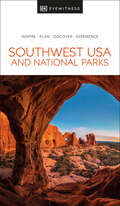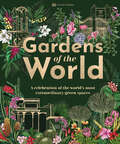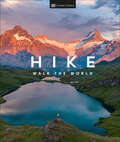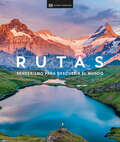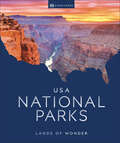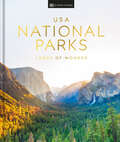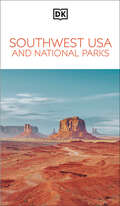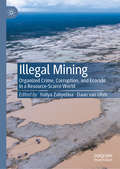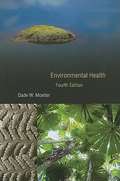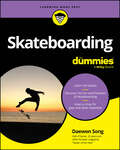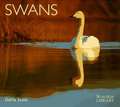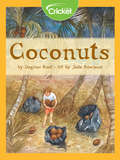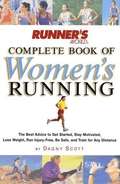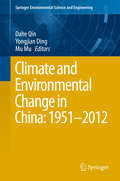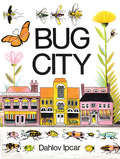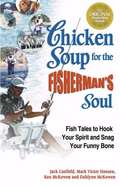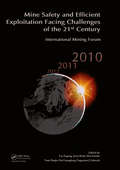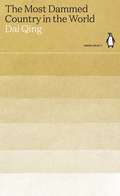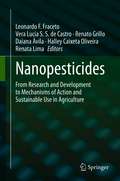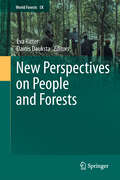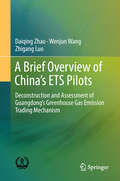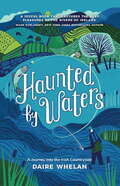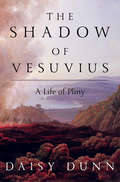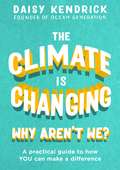- Table View
- List View
DK Eyewitness Southwest USA and National Parks (Travel Guide)
by DK EyewitnessEmbark on an outdoor adventure across the Southwest USA and its many varied and wonderful National Parks!Whether you want to unleash your inner cowboy on the ranches in Utah, take in the truly spectacular sight of the Grand Canyon, or test your luck in the casinos of Las Vegas, your DK Eyewitness travel guide makes sure you experience it all!Inside the pages of this Southwest USA and National Parks travel guide, you&’ll discover: • Our pick of Southwest USA&’s must-sees, top experiences, hidden gems, and the best spots to eat, drink, shop, and stay • Detailed maps and walks make navigating the cities and towns easy • Easy-to-follow itineraries to help you plan your trip • Expert advice and travel tips to help you get ready, get around and stay safe • Color-coded chapters to every part of Southwest USA, from the Grand Canyon, Northern Arizona, Phoenix, Southern Arizona to Southern Utah, Albuquerque, and Southern New Mexico • Available in a handy format that is lightweight and portable Find a little something for everyone down SouthIt&’s time to tick the Southwest USA off your bucket list! This updated travel guide brings this beautiful region to life, transporting you there in spectacular fashion! It&’s packed with expert-led insights, trusted travel advice, and detailed breakdowns of all the must-see sights. Stunning photographs and hand-drawn illustrations will take you through the iconic landscapes and cities of this beautiful corner of the USA.Distinguished by red sandstone mesas, cactus-studded deserts, and towering rock arches, the Southwest USA's dramatic landscapes evoke frontier legends. As rich in history and culture as natural beauty, the region's cities offer endless opportunities to experience the state's multicultural heritage.DK Eyewitness Southwest USA and National Parks have been updated regularly to make sure the information is as up-to-date as possible following the COVID-19 outbreak.Don&’t stop exploring - discover even more guides!For more than two decades, DK Eyewitness guides have helped travelers experience the world through the history, art, architecture, and culture of their destinations. Expert travel writers and researchers provide independent advice, recommendations, and reviews. Discover guidebooks to hundreds of places around the globe.Gold Award: Wanderlust Reader Travel Award 2020 in the Top Guidebook Series category.
Gardens of the World
by DK EyewitnessExplore the world's most stunning gardens and gain expert knowledge that you can use in your own green space.A celebration of the world's most extraordinary green spaces, Gardens of the World will sow the seeds of adventure and inspire your next trip.Illustrated with inspiring photography and full of fascinating insights from expert gardeners, this beautiful compilation takes you on a visual journey of some of the world's most gorgeous gardens and green spaces. The ebook is split into five chapters, each focusing on a different theme. From the intricately planned and carefully curated French formal gardens of Versailles to the surrealist jungle dreamland of Mexico's Las Pozas, these gardens prove that green-fingered ingenuity comes in many forms and thrives in even the most unlikely of locations.
Hike: Adventures on Foot
by DK EyewitnessIt&’s hard to beat the satisfaction of traveling on foot – settling into a steady rhythm, surrounded by incredible scenery, with the freedom to stop wherever takes your fancy. This endlessly rewarding – and sustainable – activity is joyously celebrated in Hike, which reveals 125 of the most scenic and spectacular walking trails across the globe. It&’s the ultimate inspiration for exploring under your own steam: ramble along coastal paths in Europe, scale soaring mountain peaks in Africa and trek through amber-hued canyons in North America.Compiled by a team of outdoor enthusiasts, this book is packed with ideas for your next hiking trip. Awe-inspiring images and compelling descriptions of each trail will have you itching to get walking, while handy maps, elevation profiles, and practical information – including things like distance and total elevation gain – will help you plan the nitty-gritty of your trip. We&’ve also included the best places to explore en route – whether that&’s lunch spots, epic viewpoints, or nearby must-see sights – as well as suggestions for alternative ways to tackle a trail. Hike is your ticket to the adventure of a lifetime. Inside Hike, you will find: - Practical top tips for getting the most out of each hike - including recommended stops, viewpoints en route, and how to make the hike shorter/longer depending on how much time you have.- Organized Chapters: Hikes are arranged within each chapter geographically, and include the distance and total ascent to help readers to find a suitable route.- Includes maps and elevation profiles - Covers 125 hikes, from straightforward day, walks to epic cross-country treks- A carefully curated selection of rides, chosen by hiking and travel experts - Each chapter covers a different continent (North America, Central, and South America, Europe, Africa, and the Middle East, Asia, Australasia)About DK Eyewitness:At DK Eyewitness, we believe in the power of discovery. We make it easy for you to explore your dream destinations. DK Eyewitness travel guides have been helping travelers to make the most of their breaks since 1993. DK Eyewitness travel guides have been helping travelers to make the most of their breaks since 1993. Filled with expert advice, striking photography and detailed illustrations, our highly visual DK Eyewitness guides will get you closer to your next adventure. We publish guides to more than 200 destinations, from pocket-sized city guides to comprehensive country guides. Named Top Guidebook Series at the 2020 Wanderlust Reader Travel Awards, we know that wherever you go next, your DK Eyewitness travel guides are the perfect companion
Rutas (Hike): Senderismo para descubrir el mundo
by DK Eyewitness* Incluye mapas y perfiles de altitud.* Abarca 125 recorridos, desde sencillas caminatas de un día hasta grandes travesías.* Incluye la ruta del Camino de Santiago y la Garganta del Cares.* Cada capítulo explora un continente diferente.125 rutas para descubrir el mundo.Es hora de calzarse las botas y emprender una gran aventura. Asciende montañas, explora la costa o atraviesa densos bosques. Este libro te invita a recorrer las 125 rutas de senderismo más pintorescas y espectaculares del mundo y te ofrece información para todo tipo de recorridos, desde suaves paseos de un día hasta épicas marchas de larga distancia. Encuentra toda la inspiración para explorar el mundo a pie.—------------* Includes maps and elevation profiles.* Covers 125 hikes, from straightforward day walks to epic cross-country treks.* Each chapter covers a different continent.Compiled by a team of outdoor enthusiasts, this book is packed with ideas for your next hiking trip. Awe-inspiring images and compelling descriptions of each trail will have you itching to get walking, while handy maps, elevation profiles, and practical information. Hike is your ticket to the adventure of a lifetime.
USA National Parks: Lands of Wonder
by DK EyewitnessBreathtaking and awe-inspiring, the USA National Parks never fail to amaze. Distinguished by rust-red canyons, snow-capped peaks and silent forests, they&’re yours to roam. Immerse yourself and your family in these ancient lands, explore their heritage and find out what makes them unique.Whether it&’s your dream to check the Grand Canyon off your bucket list, discover Alaska&’s Denali Park, and explore Florida&’s Everglades, or if you&’re simply seeking inspiration for your next trip to the great outdoors, USA National Parks Lands of Wonder ensures you experience all the American wilderness has to offer. USA National Parks Lands of Wonder truly brings all 62 National Parks to life, celebrating the country&’s most breathtaking landscapes. USA National Parks is your ticket to the trip of a lifetime. Inside USA National Parks you will find: • Inspiring photography throughout that evokes the majesty of the national parks • &‘Focus On&’ sections including features on National Parks throughout each season, best times to visit, and geographical insights • Practical tips on what to enjoy during your trip, including popular hikes, bird-watching tips, and activities for the whole family to enjoy • &‘Did You Know?&’ sections featured throughout to test your knowledge on the culture, history and wildlife of the National Parks you visit • &‘Ways To Explore&’ sections featured throughout to maximize your adventures, offering ideas such as camping, picnicking, hiking, sledging, night-watching and walking • Expert led hike Trails with easy, moderate and challenging options to plan your route ahead of your trip • Covers: Yellowstone, Yosemite, Sequoia, Mount Rainier, Crater Lake, Wind Caves, Mesa Verde, Glacier Rocky Mountain, Lassen Volcanic, Hawai&’i Volcanoes, Denali, Grand Canyon, Zion, Acadia, Hot Springs, Bryce Canyon, Grand Teton, Carlsbad Caverns, Great Smoky Mountains, Shenandoah, Olympic, Kings Canyon, Isle Royale, Mammoth Cave, Big Bend, Everglades, Virgin Islands, Haleakalā, Petrified Forest, Canyonlands, North Cascades, Redwood, Capitol Reef, Arches, Guadalupe Mountains, Voyageurs, Theodore Roosevelt, Badlands, Channel Islands, Biscayne, Katma,i Glacier Bay, Gates of the Arctic, Kenai Fjords, Kobuk Valley, Lake Clark, Wrangell St. Elias, Great Basin, National Park of American Samoa, Dry Tortugas, Death Valley, Saguaro, Joshua Tree, Black Canyon of the Gunnison, Cuyahoga Valley, Congaree, Great Sand Dunes, Pinnacles, Gateway Arch, Indiana Dunes, White Sands Seeking more adventures in the USA? Don&’t forget to check out DK Eyewitness Southwest USA, DK Eyewitness Florida, DK Eyewitness New England, DK Eyewitness Hawaii, DK Eyewitness Pacific Northwest, and DK Eyewitness USA to make the most of your trip and achieve the adventure of a lifetime.About DK Eyewitness: At DK Eyewitness, we believe in the power of discovery. We make it easy for you to explore your dream destinations. DK Eyewitness travel guides have been helping travellers to make the most of their breaks since 1993. Filled with expert advice, striking photography and detailed illustrations, our highly visual DK Eyewitness guides will get you closer to your next adventure. We publish guides to more than 200 destinations, from pocket-sized city guides to comprehensive country guides. Named Top Guidebook Series at the 2020 Wanderlust Reader Travel Awards, we know that wherever you go next, your DK Eyewitness travel guides are the perfect companion.
USA National Parks: Lands of Wonder
by DK EyewitnessThe USA&’s National Parks truly are places of wonder: staggering landscapes of jaw-dropping dimensions and incredible diversity where you can stand on the very edge of civilization.They are the earth&’s breathing spaces, precious places to conserve nature and wildlife for future generations. Explore countless places to hike, camp, climb, swim, and paddle, where you and your family can create lifelong memories of freedom and wide-open spaces.The book contains inspiring narratives reflecting the rich diversity and natural importance of the parks, including their role in conserving wildlife, their intricate ecosystems, and their importance as untamed yet accessible spaces where people love to escape and unwind. In this book, you&’ll discover: -Beautiful photography and inspiring ideas – perfect for planning your next adventure -63 national parks in order of designation, showcasing what makes each one special-Maps, facts and figures, things to do, and when and where to experience it at its bestThe book considers the history of the national parks – the ideas behind their establishment, why they hold a special place in American culture, and why they&’re more relevant than ever today. Celebrate the beauty, history, and cultural importance of America&’s 63 national parks in this revised and updated edition, which features the newest national park, New River Gorge.
DK Southwest USA and National Parks (Travel Guide)
by DK TravelEmbark on an outdoor adventure across the Southwest USA and its many varied and wonderful National Parks!Whether you want to unleash your inner cowboy on the ranches in Utah, take in the truly spectacular sight of the Grand Canyon, or test your luck in the casinos of Las Vegas, your DK Eyewitness travel guide makes sure you experience it all!Inside the pages of this Southwest USA and National Parks travel guide, you’ll discover: • Our pick of Southwest USA’s must-sees, top experiences, hidden gems, and the best spots to eat, drink, shop, and stay • Detailed maps and walks make navigating the cities and towns easy • Easy-to-follow itineraries to help you plan your trip • Expert advice and travel tips to help you get ready, get around and stay safe • Color-coded chapters to every part of Southwest USA, from the Grand Canyon, Northern Arizona, Phoenix, Southern Arizona to Southern Utah, Albuquerque, and Southern New Mexico • Available in a handy format that is lightweight and portable Find a little something for everyone down SouthIt’s time to tick the Southwest USA off your bucket list! This updated travel guide brings this beautiful region to life, transporting you there in spectacular fashion! It’s packed with expert-led insights, trusted travel advice, and detailed breakdowns of all the must-see sights. Stunning photographs and hand-drawn illustrations will take you through the iconic landscapes and cities of this beautiful corner of the USA.Distinguished by red sandstone mesas, cactus-studded deserts, and towering rock arches, the Southwest USA's dramatic landscapes evoke frontier legends. As rich in history and culture as natural beauty, the region's cities offer endless opportunities to experience the state's multicultural heritage.DK Eyewitness Southwest USA and National Parks have been updated regularly to make sure the information is as up-to-date as possible following the COVID-19 outbreak.Don’t stop exploring - discover even more guides!For more than two decades, DK Eyewitness guides have helped travelers experience the world through the history, art, architecture, and culture of their destinations. Expert travel writers and researchers provide independent advice, recommendations, and reviews. Discover guidebooks to hundreds of places around the globe.Gold Award: Wanderlust Reader Travel Award 2020 in the Top Guidebook Series category.
Illegal Mining: Organized Crime, Corruption, and Ecocide in a Resource-Scarce World
by Daan Van Uhm Yuliya ZabyelinaThis book provides a comprehensive analysis of the illegal extraction of metals and minerals from the perspectives of organized crime theory, green criminology, anti-corruption studies, and victimology. It includes contributions that focus on organized crime-related offences, such as drug trafficking and trafficking in persons, extortion, corruption and money laundering and sheds light on the serious environmental harms caused by illegal mining. Based on a wide range of case studies from the Amazon rainforest through the Ukrainian flatlands to the desert-like savanna of Central African Republic and Australia’s elevated plateaus, this book offers a unique insight into the illegal mining business and the complex relationship between organized crime, corruption, and ecocide. This is the first book-length publication on illegal extraction, trafficking in mined commodities, and ecocide associated with mining. It will appeal to scholars working on organized crime and green crime, including criminologists, sociologists, anthropologists, and legal scholars. Practitioners and the general public may welcome this comprehensive and timely publication to contemplate on resource-scarcity, security, and crime in a rapidly changing world.
Environmental Health (Fourth Edition)
by Dade W. MoellerBased on the recommendations of advisory bodies and federal agency regulations, as well as a thorough review of the scientific literature, Moeller's Fourth Edition is the only fully current text in this burgeoning field. It features new tables and figures, and revisions of those retained from previous editions. Environmental Health is also enriched with the knowledge and insights of professionals who are deeply involved in "real world" aspects of each subject covered. In eighteen chapters, students receive a complete but manageable introduction to the complex nature of the environment, how humans interact with it, and the mutual impact between people and the environments where they work or live. This new edition emphasizes the challenges students will face in the field: the local and global implications of environmental health initiatives, their short- and long-range effects, their importance to both developing and developed nations, and the roles individuals can play in helping to resolve these problems. Whether discussing toxicology, injury prevention, risk assessment, and ionizing and non-ionizing radiation, or more traditional subjects like the management and control of air, water, and food, Dade Moeller emphasizes the need for a systems approach to analyzing new projects prior to their construction and operation. Environmental Health is indispensable reading for practitioners, students, and anyone considering a career in public health.
Skateboarding For Dummies
by Daewon SongA beginner’s guide to skating for fun, fitness, and self-expression Skateboarding For Dummies teaches you the basics of the fun and popular sport of skateboarding, so you can start shredding. Author Daewon Song has been a pro skateboarder for 30 years and is considered to be the most technically gifted skateboarder of all time. He is passionate about the sport and shares his enthusiasm and experience in this easy-to-read guide. Skateboarding is a fun, challenging, and inclusive sport that can also be a powerful outlet for self-expression. With this book, you’ll learn cool tricks, safe skating, and skatepark etiquette. Plus, you’ll discover how skateboarding can bring positivity to your life, building your confidence and self-esteem. Shop for your first skateboard and essential accessories Learn the basics of riding a skateboard at a skatepark Get step-by-step instructions for performing classic tricks Discover the history of skateboardingSkateboarding is for everyone, regardless of age or background, and Skateboarding For Dummies is for anyone who wants to give this sport a try.
Swans (WorldLife Library)
by Dafila ScottIn many legends and myths, swans represent beauty, purity. Dafila Scott details everything from the appearances of these graceful creatures in myth to their ecology and life history. All eight kinds of swans are described, including information on their distribution worldwide, their population sizes, and features unique to each species. The book also introduces breeding, migration, social behavior, and mortality, along with conservation, domestication, and management issues. Gorgeous color photographs accompany the text.
Coconuts
by Dagmar KostJason helps his family prepare for hurricane Calvin. At first, he thinks his job to pick up coconuts is just because he's little and had to stay out of everybody's way. But then he learns how dangerous coconuts can be in a hurricane.
Runner's World Complete Book of Women's Running: The Best Advice to Get Started, Stay Motivated, Lose Weight, Run Injury-Free, Be Safe, and Train for Any Distance
by Dagny ScottHere, in one neat package, is pretty much everything you need to know about trail running--running, that is, on dirt trails, not pavement. It isn't (or, at least, it doesn't have to be) torture, endless hours of negotiating tricky mountain paths and inclement weather. Trail running is, we're told, less hazardous, less painful, and less exhausting than pavement-pounding. It's all about relaxation and communing with nature. The book is full of tips, some of them presented in a helpful, question-and-answer format; there's an excellent chapter on outfitting yourself for trail running; another on how best to train before a run; another on preparing, if you're so inclined, for a marathon. The author, a longtime trail runner, approaches the subject from a commonsensical, practical angle, avoiding pseudophilosophical claptrap about the deep meaning of running. Instead, he offers a hands-on, nuts-and-bolts, filled-to-the-brim users' manual that targets both veteran and beginning trail runners.
Climate and Environmental Change in China: 1951-2012 (Springer Environmental Science and Engineering)
by Dahe Qin Yongjian Ding Mu MuThrough numerous color figures and tables, this book presents the most up-to-date knowledge on climate and environmental change in China. It documents the evidence and attribution of climate and environmental changes in the past few decades and discusses the impacts of climate change on environments, economy, and society. The book further provides projections of climate change and its impacts in the future. Finally, it offers the climate change mitigation and adaption technologies with strategic options which will be of interest for policy makers, researchers and the general public as well.
Bug City
by Dahlov IpcarFollow a whimsical day in the life of a Bug City family, with imaginative illustrations of real insects by American artist Dahlov IpcarThis charming bug family (Mama is a ladybug and Papa is a daddy longlegs) share a day in Bug City, where they go shopping (for calico moths and velvet ants, of course!) and visit the zoo with rhinoceros beetles and ant lions. Their quaint, busy lives, augmented by Dahlov Ipcar's flamboyant, colorful illustrations, make a charming story for readers to enjoy and learn how to identify a wide variety of bugs.
Chicken Soup for the Fisherman's Soul: Fish Tales to Hook Your Spirit and Snag Your Funny Bone
by Mark Victor Hansen Jack L. Canfield Dahlynn Mckowen Ken MckowenMore than fish tales in this delightful book, readers will discover stories about the special relationships that develop through fishing--between parents and children, between friends and lovers, between fisherman, nature, and the elusive fish. Fishing is a common thread in many lives, and this book shows the strength and importance of those threads--whether your passion is fly-fishing, bass fishing, deepwater fishing, or just casting a line on a hot summer day. Chapters include: First Cast, Small Fries, The One That Got Away and Hooked For Love.
Mine Safety and Efficient Exploitation Facing Challenges of the 21st Century: International Mining Forum 2010
by Jerzy Kicki Eugeniusz J. Sobczyk Liu Zegong Hua Xinzhu Yuan Shujie Dai GuanglongThe International Mining Forum is a meeting of scientists and professionals for exchanging new ideas and experiences, evaluate previously implemented solutions, and discuss fresh ideas that might change the mining industry's image. In recent years theory and technology in mine safety and efficient exploitation has made considerable progress in Chin
The Most Dammed Country in the World (Green Ideas)
by Dai QingIn twenty short books, Penguin brings you the classics of the environmental movement.The courageous, unflinching speeches and writings collected in The Most Dammed Country in the World detail the devastating human and environmental cost of China's economic rise.Over the past 75 years, a new canon has emerged. As life on Earth has become irrevocably altered by humans, visionary thinkers around the world have raised their voices to defend the planet, and affirm our place at the heart of its restoration. Their words have endured through the decades, becoming the classics of a movement. Together, these books show the richness of environmental thought, and point the way to a fairer, saner, greener world.
Nanopesticides: From Research and Development to Mechanisms of Action and Sustainable Use in Agriculture
by Renato Grillo Leonardo F. Fraceto Vera Lucia S.S. de Castro Daiana Ávila Halley Caixeta Oliveira Renata LimaThis book explores the development of nanopesticides and tests of their biological activity against target organisms. It also covers the effects of nanopesticides in the aquatic and terrestrial environments, along with related subjects including fate, behaviour, mechanisms of action and toxicity. Moreover, the book discusses the potential risks of nanopesticides for non-target organisms, as well as regulatory issues and future perspectives.
New Perspectives on People and Forests
by Dainis Dauksta Eva RitterThe aim of this book is to elucidate the role of forests as part of a landscape in the life of people. Most landscapes today are cultural landscapes that are influenced by human activity and that in turn have a profound effect on our understanding of and identification with a place. The book proposes that a better understanding of the bond between people and forests as integrated part of a landscape may be helpful in landscape planning, and may contribute to the discussion of changes in forest cover which has been motivated by land use changes, rural development and the global climate debate. To this end, people's perception of forest landscapes, the reasons for different perceptions, and future perspectives are discussed. Given the wide range of forest landscapes, and cultural perspectives which exist across the world, the book focuses on Europe as a test case to explore the various relationships between society, culture, forests and landscapes. It looks at historical evidence of the impacts of people on forests and vice versa, explores the current factors affecting people's physical and emotional comfort in forest landscapes, and looks ahead to how changes in forest cover may alter the present relationships of people to forests. Drawing together a diverse literature and combining the expertise of natural and social scientists, this book will form a valuable reference for students and researchers working in the fields of landscape ecology and landscape architecture, geography, social science, environmental psychology or environmental history. It will also be of interest to researchers, government agencies and practitioners with an interest in issues such as sustainable forest management, sustainable tourism, reserve management, urban planning and environmental interpretation.
A Brief Overview of China’s ETS Pilots: Deconstruction And Assessment Of Guangdong's Greenhouse Gas Emission Trading Mechanism
by Daiqing Zhao Wenjun Wang Zhigang LuoThis book systematically introduces readers to the framework of China’s ETS pilots, exploring their design and operating process, the current state of the carbon market, and various barriers encountered. To do so, it deconstructs the Guangdong ETS, which is the largest and most representative of China’s seven ETS pilots. The book subsequently describes and evaluates all seven pilots in terms of their efficiency, macro and micro effects, the method involved in the DEA model, the CGE model, and cost-benefit analysis. In turn, in the assessment section it demonstrates how some ETS pilots have failed to control carbon emissions due to inordinately high emissions quotas issued by the local government etc. Further, it argues that ETS should focus on those industries with large emissions and high mitigating potential for the time being, and then gradually expand the scale of its coverage.As China’s national ETS is slated for launch on the basis of the lessons learned from the ETS pilots, the book offers a timely and valuable resource for all those who want to understand and forecast the development of China’s ETS. It includes a wealth of descriptions and explanations of Chinese government policies involving carbon emissions control, making it a unique resource.
Haunted by Waters: A Journey into the Irish Countryside
by Daire WhelanAward-winning producer and journalist Daire Whelan had reached the end of another busy week and couldn't shake the feeling that life was passing him by too quickly. Vowing to make a change, he decided to commit to a year of fly fishing and set about planning his route through the wild and rugged landscape of Ireland. Here, in Haunted by Waters: A Journey into the Irish Countryside we travel with Daire throughout a season of fly fishing. But as he searches for a sense of meaning, meeting kindred spirits as he explores the rivers and lakes, Daire finds himself rediscovering the majestic beauty of his native country. From fishing on our most secluded bays and wildest loughs in Connemara and Kerry, to casting a line on the rippling waters of the Suir in Tipperary, catching salmon on the Blackwater in Waterford, and the serenity of the Dodder in Dublin on a workday afternoon, Haunted by Waters is an evocative and stunning love letter to Ireland through a sport rich in tradition and storytelling.
Haunted by Waters: A Journey into the Irish Countryside
by Daire WhelanAward-winning producer and journalist Daire Whelan had reached the end of another busy week and couldn't shake the feeling that life was passing him by too quickly. Vowing to make a change, he decided to commit to a year of fly fishing and set about planning his route through the wild and rugged landscape of Ireland. Here, in Haunted by Waters: A Journey into the Irish Countryside we travel with Daire throughout a season of fly fishing. But as he searches for a sense of meaning, meeting kindred spirits as he explores the rivers and lakes, Daire finds himself rediscovering the majestic beauty of his native country. From fishing on our most secluded bays and wildest loughs in Connemara and Kerry, to casting a line on the rippling waters of the Suir in Tipperary, catching salmon on the Blackwater in Waterford, and the serenity of the Dodder in Dublin on a workday afternoon, Haunted by Waters is an evocative and stunning love letter to Ireland through a sport rich in tradition and storytelling.
The Shadow of Vesuvius: A Life Of Pliny
by Daisy Dunn“A wonderfully rich, witty, insightful, and wide-ranging portrait of the two Plinys and their world.”—Sarah Bakewell, author of How to Live When Pliny the Elder perished at Stabiae during the eruption of Vesuvius in 79 AD, he left behind an enormous compendium of knowledge, his thirty-seven-volume Natural History, and a teenaged nephew who revered him as a father. Grieving his loss, Pliny the Younger inherited the Elder’s notebooks—filled with pearls of wisdom—and his legacy. At its heart, The Shadow of Vesuvius is a literary biography of the younger man, who would grow up to become a lawyer, senator, poet, collector of villas, and chronicler of the Roman Empire from the dire days of terror under Emperor Domitian to the gentler times of Emperor Trajan. A biography that will appeal to lovers of Mary Beard books, it is also a moving narrative about the profound influence of a father figure on his adopted son. Interweaving the younger Pliny’s Letters with extracts from the Elder’s Natural History, Daisy Dunn paints a vivid, compellingly readable portrait of two of antiquity’s greatest minds.
The Climate is Changing, Why Aren't We?: A practical guide to how you can make a difference
by Daisy Kendrick'An inspirational and motivational must-read, packed with practical tips to push for positive change' Zanna van DijkThe climate is changing, so why aren't we? After all, we are the generation of change. The severity of climate change leaves no one indifferent. The Climate is Changing, Why Aren't We? will not try to convince you that climate change exists - we know that. It offers easy to understand insights into the structures that suffocate our future, while upholding a sense of optimism and humanising the climate story. From the clothes you buy, plastics you use and food you eat, to knowing how to harness the power of social media and technology to get our voices heard and demand climate action, Daisy Kendrick, founder of Ocean Generation, weaves together inspirational stories, shocking statistics and easy green switches to make in your everyday life to tackle climate change on an individual level. The Climate is Changing, Why Aren't We? will help to grant future generations the rights they deserve.
